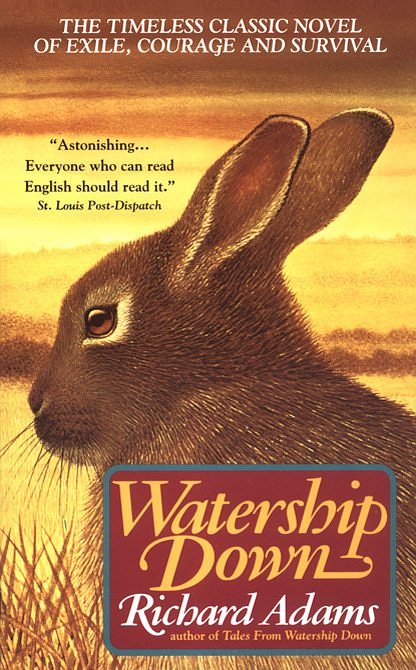I’ve been thinking recently about books I enjoyed as a kid. Animorphs, Hank the Cowdog, Little House on the Prarie. There were many books I read when very young that had a lasting impact, but fewer had more so, perhaps than Watership Down.
On the surface, this tale seems fairly straightforward. After a young rabbit has a vision of their warren being destroyed by humans, a group of rabbits evacuate and seek a new home. They encounter many challenges along the way, both in trying to fit into existing warrens and finally in trying to establish their own.
Now I’m aware, looking back on the book as an adult, that there are some issues in terms of the gender roles in it. The female characters really do get short shrift overall, and it would have been nice if they’d had a role and development on par with the male characters. But the story is good enough these shortcomings barely hamper the experience (or at least they didn’t for me at the time). The book is an enduring classic, one of the few that I’ve returned to several times over the years.
Perhaps one of the biggest lessons that Watership Down taught me was about world building. I think it was while reading this book for the first time that I really became aware of world building as a concept.
Of course, I had read other books that involved world building. James and the Giant Peach, Animorphs and so on. This book, though, was the first that made me really stop and think about the fact that all of these worlds had to be crafted by the writers. Constructed through an exercise of will and imagination so as to blossom to life on the page.
I mean, clearly, Richard Adams didn’t go out and interview a bunch of rabbits about their religion and culture to figure out the different ways that the societies of rabbits function. Rabbits are notoriously closed mouthed to foreigners, after all. No, he had invented all of it, and the rich tapestry resulting mesmerized my young mind and tantalized it with possibilities if I could tap into this incredible ability.
The book also taught me the importance of change in a novel. Nothing is ever static for the characters in Watership Down. From the very moment of the novel’s outset things are in a state of flux. And while it creates a sense of unease and almost angst on behalf of the characters, the need to keep going and see if the characters pull it through, in the end, is a powerful motivator to read on. Hazel, Bigwig, Dandelion and the rest become that much more real for the fact that their reality isn’t set in stone. Whether it’s fleeing the Owsla to avoid getting caught in a genocide, escaping from a cultish warren, or covert operations in a fascist warren in order to liberate females for their own home. Change is always there, within the world and the characters both.
As those close to me can tell you, I’ve always had a bit of problem with big changes in my life. But thinking back on these rabbits in this book and how they rose to the challenges of their ever-changing life circumstance can sometimes help ease me through it. Just one of many positive influences the book has had.
Most importantly though, Watership Down taught me about the importance of having an emotional connection with a character. I will never forget the moment when one of my favorite characters, the seagull Keehar, leaves his rabbit friends in order to return to the big water. I didn’t want Keehar to leave. I wanted him to stay and continue going on adventures with his rabbit friends. Yet, at the same time, it was clear that leaving was best for Keehar and I wanted him to have that. The dichotomy of those desires was bittersweet.
Now it has been many years since I’ve read Watership Down, but I think someday soon I may need to pull it out and give it a fresh read. A book that has had such an important impact on my life deserves to be loved and revered in all stages of life, I should think.
I want to know, dear readers, do you have a book that has impacted you like this? Tell me about it in the comments.


